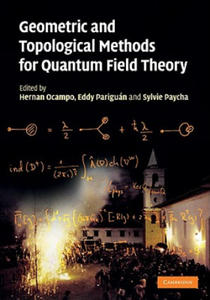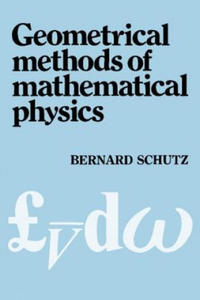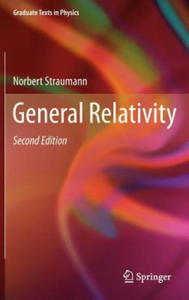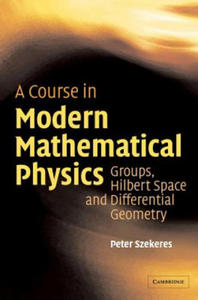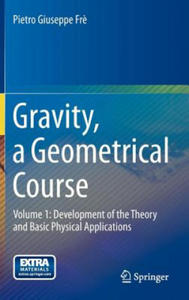krainaksiazek introduction to differential geometry 20107112
- znaleziono 78 produktów w 5 sklepach
Variational Principles of Mechanics Dover Publications
Książki / Literatura obcojęzyczna
Introduction 1. The variational approach to mechanics 2. The procedure of Euler and Lagrange 3. Hamilton's procedure 4. The calculus of variations 5. Comparison between the vectorial and the variational treatments of mechanics 6. Mathematical evaluation of the variational principles 7. Philosophical evaluation of the variational approach to mechanics I. The Basic Concepts of Analytical Mechanics 1. The Principal viewpoints of analytical mechanics 2. Generalized coordinates 3. The configuration space 4. Mapping of the space on itself 5. Kinetic energy and Riemannian geometry 6. Holonomic and non-holonomic mechanical systems 7. Work function and generalized force 8. Scleronomic and rheonomic systems. The law of the conservation of energy II. The Calculus of Variations 1. The general nature of extremum problems 2. The stationary value of a function 3. The second variation 4. Stationary value versus extremum value 5. Auxiliary conditions. The Lagrangian lambda-method 6. Non-holonomic auxiliary conditions 7. The stationary value of a definite integral 8. The fundamental processes of the calculus of variations 9. The commutative properties of the delta-process 10. The stationary value of a definite integral treated by the calculus of variations 11. The Euler-Lagrange differential equations for n degrees of freedom 12. Variation with auxiliary conditions 13. Non-holonomic conditions 14. Isoperimetric conditions 15. The calculus of variations and boundary conditions. The problem of the elastic bar III. The principle of virtual work 1. The principle of virtual work for reversible displacements 2. The equilibrium of a rigid body 3. Equivalence of two systems of forces 4. Equilibrium problems with auxiliary conditions 5. Physical interpretation of the Lagrangian multiplier method 6. Fourier's inequality IV. D'Alembert's principle 1. The force of inertia 2. The place of d'Alembert's principle in mechanics 3. The conservation of energy as a consequence of d'Alembert's principle 4. Apparent forces in an accelerated reference system. Einstein's equivalence hypothesis 5. Apparent forces in a rotating reference system 6. Dynamics of a rigid body. The motion of the centre of mass 7. Dynamics of a rigid body. Euler's equations 8. Gauss' principle of least restraint V. The Lagrangian equations of motion 1. Hamilton's principle 2. The Lagrangian equations of motion and their invariance relative to point transformations 3. The energy theorem as a consequence of Hamilton's principle 4. Kinosthenic or ignorable variables and their elimination 5. The forceless mechanics of Hertz 6. The time as kinosthenic variable; Jacobi's principle; the principle of least action 7. Jacobi's principle and Riemannian geometry 8. Auxiliary conditions; the physical significance of the Lagrangian lambda-factor 9. Non-holonomic auxiliary conditions and polygenic forces 10. Small vibrations about a state of equilibrium VI. The Canonical Equations of motion 1. Legendre's dual transformation 2. Legendre's transformation applied to the Lagrangian function 3. Transformation of the Lagrangian equations of motion 4. The canonical integral 5. The phase space and the space fluid 6. The energy theorem as a consequence of the canonical equations 7. Liouville's theorem 8. Integral invariants, Helmholtz' circulation theorem 9. The elimination of ignorable variables 10. The parametric form of the canonical equations VII. Canonical Transformations 1. Coordinate transformations as a method of solving mechanical problems 2. The Lagrangian point transformations 3. Mathieu's and Lie's transformations 4. The general canonical transformation 5. The bilinear differential form 6. The bracket expressions of Lagrange and Poisson 7. Infinitesimal canonical transformations 8. The motion of the phase fluid as a continuous succession of canonical transformations 9. Hamilton's principal function and the motion of the phase fluid VIII. The Partial differential equation of Hamilton-Jacobi 1. The importance of the generating function for the problem of motion 2. Jacobi's transformation theory 3. Solution of the partial differential equation by separation 4. Delaunay's treatment of separable periodic systems 5. The role of the partial differential equation in the theories of Hamilton and Jacobi 6. Construction of Hamilton's principal function with the help of Jacobi's complete solution 7. Geometrical solution of the partial differential equation. Hamilton's optico-mechanical analogy 8. The significance of Hamilton's partial differential equation in the theory of wave motion 9. The geometrization of dynamics. Non-Riemannian geometrics. The metrical significance of Hamilton's partial differential equation IX. Relativistic Mechanics 1. Historical Introduction 2. Relativistic kinematics 3. Minkowski's four-dimensional world 4. The Lorentz transformations 5. Mechanics of a particle 6. The Hamiltonian formulation of particle dynamics 7. The potential energy V 8. Relativistic formulation of Newton's scalar theory of gravitation 9. Motion of a charged particle 10. Geodesics of a four-dimensional world 11. The planetary orbits in Einstein's gravitational theory 12. The gravitational bending of light rays 13. The gravitational red-shirt of the spectral lines Bibliography X. Historical Survey XI. Mechanics of the Continua 1. The variation of volume integrals 2. Vector-analytic tools 3. Integral theorems 4. The conservation of mass 5. Hydrodynamics of ideal fluids 6. The hydrodynamic equations in Lagrangian formulation 7. Hydrostatics 8. The circulation theorem 9. Euler's form of the hydrodynamic equations 10. The conservation of energy 11. Elasticity. Mathematical tools 12. The strain tensor 13. The stress tensor 14. Small elastic vibrations 15. The Hamiltonization of variational problems 16. Young's modulus. Poisson's ratio 17. Elastic stability 18. Electromagnetism. Mathematical tools 19. The Maxwell equations 20. Noether's principle 21. Transformation of the coordinates 22. The symmetric energy-momentum tensor 23. The ten conservation laws 24. The dynamic law in field theoretical derivation Appendix I; Appendix II; Bibliography; Index
Sklep: Libristo.pl
Variational Principles of Mechanics Dover Publications Inc.
Książki / Literatura obcojęzyczna
Introduction 1. The variational approach to mechanics 2. The procedure of Euler and Lagrange 3. Hamilton's procedure 4. The calculus of variations 5. Comparison between the vectorial and the variational treatments of mechanics 6. Mathematical evaluation of the variational principles 7. Philosophical evaluation of the variational approach to mechanicsI. The Basic Concepts of Analytical Mechanics 1. The Principal viewpoints of analytical mechanics 2. Generalized coordinates 3. The configuration space 4. Mapping of the space on itself 5. Kinetic energy and Riemannian geometry 6. Holonomic and non-holonomic mechanical systems 7. Work function and generalized force 8. Scleronomic and rheonomic systems. The law of the conservation of energyII. The Calculus of Variations 1. The general nature of extremum problems 2. The stationary value of a function 3. The second variation 4. Stationary value versus extremum value 5. Auxiliary conditions. The Lagrangian lambda-method 6. Non-holonomic auxiliary conditions 7. The stationary value of a definite integral 8. The fundamental processes of the calculus of variations 9. The commutative properties of the delta-process 10. The stationary value of a definite integral treated by the calculus of variations 11. The Euler-Lagrange differential equations for n degrees of freedom 12. Variation with auxiliary conditions 13. Non-holonomic conditions 14. Isoperimetric conditions 15. The calculus of variations and boundary conditions. The problem of the elastic barIII. The principle of virtual work 1. The principle of virtual work for reversible displacements 2. The equilibrium of a rigid body 3. Equivalence of two systems of forces 4. Equilibrium problems with auxiliary conditions 5. Physical interpretation of the Lagrangian multiplier method 6. Fourier's inequalityIV. D'Alembert's principle 1. The force of inertia 2. The place of d'Alembert's principle in mechanics 3. The conservation of energy as a consequence of d'Alembert's principle 4. Apparent forces in an accelerated reference system. Einstein's equivalence hypothesis 5. Apparent forces in a rotating reference system 6. Dynamics of a rigid body. The motion of the centre of mass 7. Dynamics of a rigid body. Euler's equations 8. Gauss' principle of least restraintV. The Lagrangian equations of motion 1. Hamilton's principle 2. The Lagrangian equations of motion and their invariance relative to point transformations 3. The energy theorem as a consequence of Hamilton's principle 4. Kinosthenic or ignorable variables and their elimination 5. The forceless mechanics of Hertz 6. The time as kinosthenic variable; Jacobi's principle; the principle of least action 7. Jacobi's principle and Riemannian geometry 8. Auxiliary conditions; the physical significance of the Lagrangian lambda-factor 9. Non-holonomic auxiliary conditions and polygenic forces 10. Small vibrations about a state of equilibriumVI. The Canonical Equations of motion 1. Legendre's dual transformation 2. Legendre's transformation applied to the Lagrangian function 3. Transformation of the Lagrangian equations of motion 4. The canonical integral 5. The phase space and the space fluid 6. The energy theorem as a consequence of the canonical equations 7. Liouville's theorem 8. Integral invariants, Helmholtz' circulation theorem 9. The elimination of ignorable variables 10. The parametric form of the canonical equationsVII. Canonical Transformations 1. Coordinate transformations as a method of solving mechanical problems 2. The Lagrangian point transformations 3. Mathieu's and Lie's transformations 4. The general canonical transformation 5. The bilinear differential form 6. The bracket expressions of Lagrange and Poisson 7. Infinitesimal canonical transformations 8. The motion of the phase fluid as a continuous succession of canonical transformations 9. Hamilton's principal function and the motion of the phase fluidVIII. The Partial differential equation of Hamilton-Jacobi 1. The importance of the generating function for the problem of motion 2. Jacobi's transformation theory 3. Solution of the partial differential equation by separation 4. Delaunay's treatment of separable periodic systems 5. The role of the partial differential equation in the theories of Hamilton and Jacobi 6. Construction of Hamilton's principal function with the help of Jacobi's complete solution 7. Geometrical solution of the partial differential equation. Hamilton's optico-mechanical analogy 8. The significance of Hamilton's partial differential equation in the theory of wave motion 9. The geometrization of dynamics. Non-Riemannian geometrics. The metrical significance of Hamilton's partial differential equationIX. Relativistic Mechanics 1. Historical Introduction 2. Relativistic kinematics 3. Minkowski's four-dimensional world 4. The Lorentz transformations 5. Mechanics of a particle 6. The Hamiltonian formulation of particle dynamics 7. The potential energy V 8. Relativistic formulation of Newton's scalar theory of gravitation 9. Motion of a charged particle 10. Geodesics of a four-dimensional world 11. The planetary orbits in Einstein's gravitational theory 12. The gravitational bending of light rays 13. The gravitational red-shirt of the spectral lines BibliographyX. Historical SurveyXI. Mechanics of the Continua 1. The variation of volume integrals 2. Vector-analytic tools 3. Integral theorems 4. The conservation of mass 5. Hydrodynamics of ideal fluids 6. The hydrodynamic equations in Lagrangian formulation 7. Hydrostatics 8. The circulation theorem 9. Euler's form of the hydrodynamic equations 10. The conservation of energy 11. Elasticity. Mathematical tools 12. The strain tensor 13. The stress tensor 14. Small elastic vibrations 15. The Hamiltonization of variational problems 16. Young's modulus. Poisson's ratio 17. Elastic stability 18. Electromagnetism. Mathematical tools 19. The Maxwell equations 20. Noether's principle 21. Transformation of the coordinates 22. The symmetric energy-momentum tensor 23. The ten conservation laws 24. The dynamic law in field theoretical derivation Appendix I; Appendix II; Bibliography; Index
Sklep: Libristo.pl
Mathematics for Computer Graphics Springer, Berlin
Książki / Literatura obcojęzyczna
John Vince explains a comprehensive range of mathematical techniques and problem-solving strategies associated with computer games, computer animation, special effects, virtual reality, CAD and other areas of computer graphics in this completely revised and expanded sixth edition. The first five chapters cover a general introduction, number sets, algebra, trigonometry and coordinate systems, which are employed in the following chapters on determinants, vectors, matrix algebra, complex numbers, geometric transforms, quaternion algebra, quaternions in space, interpolation, curves and patches, analytical geometry and barycentric coordinates. Following this, the reader is introduced to the relatively new subject of geometric algebra, followed by two chapters that introduce differential and integral calculus. Finally, there is a chapter on worked examples.Mathematics for Computer Graphics covers all of the key areas of the subject, including:- Number sets - Algebra - Trigonometry - Complex numbers - Coordinate systems - Determinants - Vectors - Quaternions - Matrix algebra - Geometric transforms - Interpolation - Curves and surfaces - Analytic geometry - Barycentric coordinates - Geometric algebra - Differential calculus - Integral calculus This sixth edition contains approximately 150 worked examples and over 330 colour illustrations, which are central to the author's descriptive writing style. Mathematics for Computer Graphics provides a sound understanding of the mathematics required for computer graphics software and setting the scene for further reading of more advanced books and technical research papers
Sklep: Libristo.pl
Advanced Calculus De Gruyter
Książki / Literatura obcojęzyczna
This textbook offers a high-level introduction to multi-variable differential calculus. By introducing differential forms early as a basic concept, the structures behind Stokes' and Gauss' theorems become much clearer. Furthermore, it offers a natural route to differential geometry.
Sklep: Libristo.pl
Geometric and Topological Methods for Quantum Field Theory Cambridge University Press
Książki / Literatura obcojęzyczna
Aimed at graduate students in physics and mathematics, this book provides an introduction to recent developments in several active topics at the interface between algebra, geometry, topology and quantum field theory. The first part of the book begins with an account of important results in geometric topology. It investigates the differential equation aspects of quantum cohomology, before moving on to noncommutative geometry. This is followed by a further exploration of quantum field theory and gauge theory, describing AdS/CFT correspondence, and the functional renormalization group approach to quantum gravity. The second part covers a wide spectrum of topics on the borderline of mathematics and physics, ranging from orbifolds to quantum indistinguishability and involving a manifold of mathematical tools borrowed from geometry, algebra and analysis. Each chapter presents introductory material before moving on to more advanced results. The chapters are self-contained and can be read independently of the rest.
Sklep: Libristo.pl
Geometrical Methods of Mathematical Physics Cambridge University Press
Książki / Literatura obcojęzyczna
In recent years the methods of modern differential geometry have become of considerable importance in theoretical physics and have found application in relativity and cosmology, high-energy physics and field theory, thermodynamics, fluid dynamics and mechanics. This textbook provides an introduction to these methods - in particular Lie derivatives, Lie groups and differential forms - and covers their extensive applications to theoretical physics. The reader is assumed to have some familiarity with advanced calculus, linear algebra and a little elementary operator theory. The advanced physics undergraduate should therefore find the presentation quite accessible. This account will prove valuable for those with backgrounds in physics and applied mathematics who desire an introduction to the subject. Having studied the book, the reader will be able to comprehend research papers that use this mathematics and follow more advanced pure-mathematical expositions.
Sklep: Libristo.pl
General Relativity Springer
Książki / Literatura obcojęzyczna
This book provides a completely revised and expanded version of the previous classic edition General Relativity and Relativistic Astrophysics . In Part I the foundations of general relativity are thoroughly developed, while Part II is devoted to tests of general relativity and many of its applications. Binary pulsars our best laboratories for general relativity are studied in considerable detail. An introduction to gravitational lensing theory is included as well, so as to make the current literature on the subject accessible to readers. Considerable attention is devoted to the study of compact objects, especially to black holes. This includes a detailed derivation of the Kerr solution, Israel s proof of his uniqueness theorem, and a derivation of the basic laws of black hole physics. Part II ends with Witten s proof of the positive energy theorem, which is presented in detail, together with the required tools on spin structures and spinor analysis. In Part III, all of the differential geometric tools required are developed in detail. §A great deal of effort went into refining and improving the text for the new edition. New material has been added, including a chapter on cosmology. The book addresses undergraduate and graduate students in physics, astrophysics and mathematics. It utilizes a very well structured approach, which should help it continue to be a standard work for a modern treatment of gravitational physics. The clear presentation of differential geometry also makes it useful for work on string theory and other fields of physics, classical as well as §quantum.
Sklep: Libristo.pl
Mathematical Physics Springer International Publishing AG
Książki / Literatura obcojęzyczna
The goal of this book is to expose the reader to the indispensable role that mathematics---often very abstract---plays in modern physics. Starting with the notion of vector spaces, the first half of the book develops topics as diverse as algebras, classical orthogonal polynomials, Fourier analysis, complex analysis, differential and integral equations, operator theory, and multi-dimensional Green's functions. The second half of the book introduces groups, manifolds, Lie groups and their representations, Clifford algebras and their representations, and fiber bundles and their applications to differential geometry and gauge theories.§This second edition is a substantial revision of the first one with a complete rewriting of many chapters and the addition of new ones, including chapters on algebras, representation of Clifford algebras and spinors, fiber bundles, and gauge theories. The spirit of the first edition, namely the balance between rigor and physical application, has been maintained, as is the abundance of historical notes and worked out examples that demonstrate the "unreasonable effectiveness of mathematics" in modern physics.§Einstein has famously said, "The most incomprehensible thing about nature is that it is comprehensible." What he had in mind was reiterated in another one of his famous quotes concerning the question of how " ... mathematics, being after all a product of human thought, is so admirably appropriate to the objects of reality." It is a question that comes to everyone's mind when encountering the highly abstract mathematics required for a deep understanding of modern physics. It is the experience that Eugene Wigner so profoundly described as "the unreasonable effectiveness of mathematics in the natural sciences."§Some praise for the previous edition:§PAGEOPH [Pure and Applied Geophysics]§Review by Daniel Wojcik, University of Maryland§"This volume should be a welcome addition to any collection. The book is well written and explanations are usually clear. Lives of famous mathematicians and physicists are scattered within the book. They are quite extended, often amusing, making nice interludes. Numerous exercises help the student practice the methods introduced. I have recently been using this book for an extended time and acquired a liking for it. Among all the available books treating mathematical methods of physics this one certainly stands out and assuredly it would suit the needs of many physics readers."§ZENTRALBLATT MATH§Review by G.Roepstorff, University of Aachen, Germany§" Unlike most existing texts with the same emphasis and audience, which are merely collections of facts and formulas, the present book is more systematic, self-contained, with a level of presentation that tends to be more formal and abstract. This entails proving a large number of theorems, lemmas, and corollaries, deferring most of the applications that physics students might be interested in to the example sections in small print. Indeed, there are 350 worked-out examples and about 850 problems. A very nice feature is the way the author intertwines the formalism with the life stories and anecdotes of some mathematicians and physicists, leading at their times. As is often the case, the historical view point helps to understand and appreciate the ideas presented in the text. For the physics student in the middle of his training, it will certainly prove to be extremely useful." §THE PHYSICIST §Review by Paul Davies, Orion Productions, Adelaide, Australia§"I am pleased to have so many topics collected in a single volume. All the tricks are there of course, but supported by sufficient rigour and substantiation to make the dedicated mathematical physicist sigh with delight."§EMS [EUROPEAN MATHEMATICAL SOCIETY] NEWSLETTER§"This book is a condensed exposition of the mathematics that is met in most parts of physics. The presentation attains a very good balance between the formal introduction of concepts, theorems and pr
Sklep: Libristo.pl
Essential Real Analysis Springer International Publishing AG
Książki / Literatura obcojęzyczna
This book provides a rigorous introduction to the techniques and results of real analysis, metric spaces and multivariate differentiation, suitable for undergraduate courses.Starting from the very foundations of analysis, it offers a complete first course in real analysis, including topics rarely found in such detail in an undergraduate textbook such the construction of non-analytic smooth functions, applications of the Euler-Maclaurin formula to estimates, and fractal geometry. Drawing on the author's extensive teaching and research experience, the exposition is guided by carefully chosen examples and counter-examples, with the emphasis placed on the key ideas underlying the theory. Much of the content is informed by its applicability: Fourier analysis is developed to the point where it can be rigorously applied to partial differential equations or computation, and the theory of metric spaces includes applications to ordinary differential equations and fractals.Essential Real Analysis will appeal to students in pure and applied mathematics, as well as scientists looking to acquire a firm footing in mathematical analysis. Numerous exercises of varying difficulty, including some suitable for group work or class discussion, make this book suitable for self-study as well as lecture courses.
Sklep: Libristo.pl
General Relativity Cambridge University Press
Książki / Literatura obcojęzyczna
General Relativity: An Introduction for Physicists provides a clear mathematical introduction to Einstein's theory of general relativity. It presents a wide range of applications of the theory, concentrating on its physical consequences. After reviewing the basic concepts, the authors present a clear and intuitive discussion of the mathematical background, including the necessary tools of tensor calculus and differential geometry. These tools are then used to develop the topic of special relativity and to discuss electromagnetism in Minkowski spacetime. Gravitation as spacetime curvature is then introduced and the field equations of general relativity derived. After applying the theory to a wide range of physical situations, the book concludes with a brief discussion of classical field theory and the derivation of general relativity from a variational principle. Written for advanced undergraduate and graduate students, this approachable textbook contains over 300 exercises to illuminate and extend the discussion in the text.
Sklep: Libristo.pl
Wstęp do geometrii różniczkowej Wydawnictwo Uniwersytetu Jagiellońskiego
Szkoły policealne. Szkoły wyższe
Proponowany podręcznik powstał po przeprowadzeniu cyklu 30-godzinnych wykładów ze wstępu z geometrii różniczkowej, które prowadziliśmy dla studentów II roku matematyki na Uniwersytecie Jagiellońskim. Podręcznik ten jest rozbudowany w stosunku do tego wykładu. Na jego realizację potrzeba naszym zdaniem, poświęcić 45-60 godzin wykładu. Ogólny pomysł podręcznika jest zgodny z duchem wykładu. Trudno zdecydować, jakie treści powinny się znaleźć w krótkim wykładzie pod tytułem "Wstęp do geometrii różniczkowej". Zwłaszcza, że dla wielu studentów wykład ten jest jedynym kontaktem z geometrią różniczkową w czasie całych studiów. Geometria różniczkowa jest ogromną dziedziną i każdy wybór wstępnych wiadomości byłby niewystarczający. Wystarczy zauważyć, że pięciotomowe dzieło M. Spivaka A. Comprehensive Introduction to Differential Geometry, [24], również nie zawiera wstępu do wszystkich działów geometrii różniczkowej. Na ogół, w ramach wstępu do geometrii różniczkowej wykłada się klasyczną teorię krzywych i powierzchni w R3. Jest to zgodne z kolejnością hostoryczną i ponadto dotyczy obiektów, które można zobaczyć "gołym okiem". Z drugiej jednak strony uważamy, że współczesny absolwent uważamy, że współczesny absolwent studiów matematycznych, powinien znać przynajmniej elementy analizy i geometrii na abstrakcyjnych (nie zanurzonych) rozmaitościach i wiedzieć, co to jest rozmaitość riemannowska czy koneksja. Jest to już również materiał, jak najbardziej "klasyczny", a jego znajomość jest przydatna, niekiedy zaś nieodzowna, w studiowaniu wielu innych działów matematyki, a także fizyki. Absolwent matematyki powinien być przygotowany do studiowania prac zawierających elementy wpółczesnej geometrii różniczkowej. Mając na uwadze te fakty, postanowiliśmy rozdzielić teorię krzywych od teorii powierzchni rozdziałami dotyczącymi rozmaitości i struktur metrycznych i afinicznych (zadanych koneksjami liniowymi) na rozmaitościach . Przy takiej konstrukcji wykładu, teoria powierzchni może być prezentowana z zastosowaniem wiadomości o rozmaitościach abstrakcyjnych i z użyciem tak zwanego zapisu niezmiennego, to znaczy niezależnego od układów współrzędnych. Na przykład, zamiast mówić o powierzchni jako o tworze pokrytym płatami prostymi, można mówić o 2-wymiarowych podrozmaitościach w sensie immersji. Mając już pojęcie krzywizny sekcyjnej.
Sklep: Booknet.net.pl
Topology Springer International Publishing AG
Książki / Literatura obcojęzyczna
This book provides a concise introduction to topology and is necessary for courses in differential geometry, functional analysis, algebraic topology, etc. Topology is a fundamental tool in most branches of pure mathematics and is also omnipresent in more applied parts of mathematics. Therefore students will need fundamental topological notions already at an early stage in their bachelor programs.§§While there are already many excellent monographs on general topology, most of them are too large for a first bachelor course. Topology fills this gap and can be either used for self-study or as the basis of a topology course.§
Sklep: Libristo.pl
Course in Modern Mathematical Physics Cambridge University Press
Książki / Literatura obcojęzyczna
This book, first published in 2004, provides an introduction to the major mathematical structures used in physics today. It covers the concepts and techniques needed for topics such as group theory, Lie algebras, topology, Hilbert space and differential geometry. Important theories of physics such as classical and quantum mechanics, thermodynamics, and special and general relativity are also developed in detail, and presented in the appropriate mathematical language. The book is suitable for advanced undergraduate and beginning graduate students in mathematical and theoretical physics, as well as applied mathematics. It includes numerous exercises and worked examples, to test the reader's understanding of the various concepts, as well as extending the themes covered in the main text. The only prerequisites are elementary calculus and linear algebra. No prior knowledge of group theory, abstract vector spaces or topology is required.
Sklep: Libristo.pl
Essential John Nash Princeton University Press
Książki / Literatura obcojęzyczna
When John Nash won the Nobel prize in economics in 1994, many people were surprised to learn that he was alive and well. Since then, Sylvia Nasar's celebrated biography "A Beautiful Mind", the basis of a new major motion picture, has revealed the man. "The Essential John Nash" reveals his work - in his own words. This book presents, for the first time, the full range of Nash's diverse contributions not only to game theory, for which he received the Nobel, but to pure mathematics - from Riemannian geometry and partial differential equations - in which he commands even greater acclaim among academics. Included are nine of Nash's most influential papers, most of them written over the decade beginning in 1949.From 1959 until his astonishing remission three decades later, the man behind the concepts 'Nash equilibrium' and 'Nash bargaining' - concepts that today pervade not only economics but nuclear strategy and contract talks in major league sports - had lived in the shadow of a condition diagnosed as paranoid schizophrenia.In the introduction to this book, Nasar recounts how Nash had, by the age of thirty, gone from being a wunderkind at Princeton and a rising mathematical star at MIT to the depths of mental illness. In his preface, Harold Kuhn offers personal insights on his longtime friend and colleague; and in introductions to several of Nash's papers, he provides scholarly context. In an afterword, Nash describes his current work, and he discusses an error in one of his papers. A photo essay in this book, chronicles Nash's career from his student days in Princeton to the present. Also included are Nash's Nobel citation and autobiography."The Essential John Nash" makes it plain why one of Nash's colleagues termed his style of intellectual inquiry as 'like lightning striking'. All those inspired by Nash's dazzling ideas will welcome this unprecedented opportunity to trace these ideas back to the exceptional mind they came from.
Sklep: Libristo.pl
Gravity, a Geometrical Course Springer
Książki / Literatura obcojęzyczna
Gravity, a Geometrical Course presents general relativity (GR) in a systematic and exhaustive way, covering three aspects that are homogenized into a single texture: i) the mathematical, geometrical foundations, exposed in a self consistent contemporary formalism, ii) the main physical, astrophysical and cosmological applications, updated to the issues of contemporary research and observations, with glimpses on supergravity and superstring theory, iii) the historical development of scientific ideas underlying both the birth of general relativity and its subsequent evolution. The book, divided in two volumes, is a rich resource for graduate students and those who wish to gain a deep knowledge of the subject without an instructor. §Volume One is dedicated to the development of the theory and basic physical applications. It guides the reader from the foundation of special relativity to Einstein field equations, illustrating some basic applications in astrophysics. A detailed account of the historical and conceptual development of the theory is combined with the presentation of its mathematical foundations. Differentiable manifolds, fibre-bundles, differential forms, and the theory of connections are covered, with a sketchy introduction to homology and cohomology. (Pseudo)-Riemannian geometry is presented both in the metric and in the vielbein approach. Physical applications include the motions in a Schwarzschild field leading to the classical tests of GR (light-ray bending and periastron advance) discussion of relativistic stellar equilibrium, white dwarfs, Chandrasekhar mass limit and polytropes. An entire chapter is devoted to tests of GR and to the indirect evidence of gravitational wave emission. The formal structure of gravitational theory is at all stages compared with that of non gravitational gauge theories, as a preparation to its modern extension, namely supergravity, discussed in the second volume. §Pietro Fr
Sklep: Libristo.pl
szukaj w Kangoo krainaksiazek introduction to differential geometry 20107112
Sklepy zlokalizowane w miastach: Warszawa, Kraków, Łódź, Wrocław, Poznań, Gdańsk, Szczecin, Bydgoszcz, Lublin, Katowice
Szukaj w sklepach lub całym serwisie
1. Sklepy z krainaksiazek introduction to differential geometry 20107112
2. Szukaj na wszystkich stronach serwisu
t1=0.057, t2=0, t3=0, t4=0.014, t=0.057




